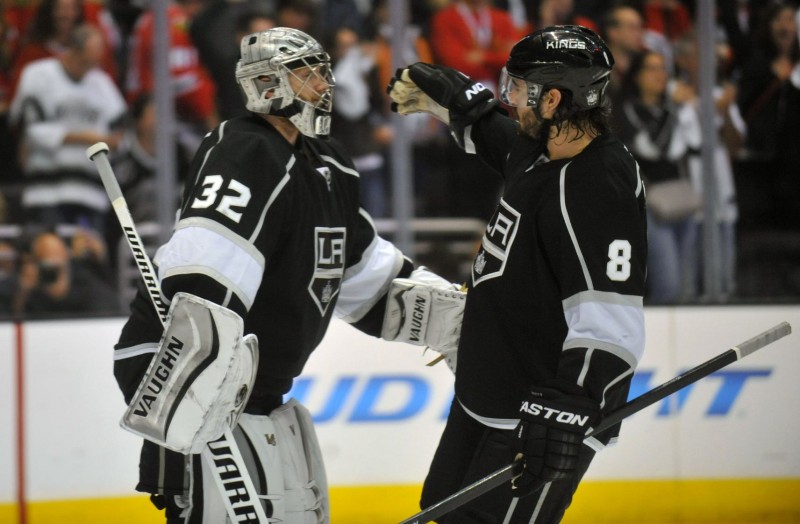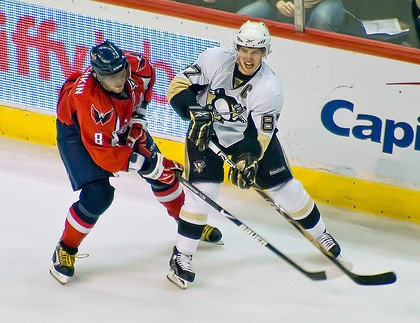There is no sugar-coating it, the NHL has entered another “Dead Puck Era.” Since 2006, there have been multiple trends that match the original Dead Puck Era which lasted from 1995-2004. During that time there were three key factors that changed within the game of hockey. These included a decrease in goals, shots and powerplay conversion rates. These league wide statistics were also the lowest or near the bottom since the league first expanded in 1967. If the NHL wants to continue to grow the sport through expansion, increasing its fan base or financially they need to address this problem now rather than later.
A Fast Descent
The best way for the NHL to solve this issue is to understand the past and learn from it. During the 1995 season the NHL enjoyed 2.99 goals and 29.3 shots per team or nearly six goals and 58.6 shots per game. By 2004, those numbers shrank to just over five goals and 56.0 shots per game. Between those years the average powerplay conversion rate was 15.08% at its lowest and 17.93% at its highest. Until 1995, the NHL only had two seasons with powerplay conversion rates under 18% since the first expansion. Just a decade earlier the NHL was enjoying the most offensive hockey in modern history. On top of that, no major rule changes that affected goal output were made to the game of hockey between 1980 and 2000. Video review, goal crease size, high-sticking and overtime were all rule changes during this time but none truly had an affect on scoring. So what happened?
How did the NHL go from seven to eight goals per game in the eighties down to five so rapidly? How did shots decrease from 60-62 in the eighties to under 58 in the nineties? How did powerplay rates decrease from 20-22 percent to under 18 percent? Looking back a few factors caused this to happen. Goaltender equipment kept increasing, players continued get bigger and faster but in the end it was adaptation. After a decade of dominance by superstars such as Wayne Gretzky and Mario Lemieux everyone was looking for a way to beat offensive hockey. In the end it was accomplished in the form of the Neutral Zone Trap. It is no coincidence that the New Jersey Devils rose to prominence with this style of hockey and also won the Stanley Cup in 1995. Because of these factors the NHL entered the original Dead Puck Era which eventually ended in a lockout.

What Happened?
So what has now caused this New Dead Puck Era? In short a variety of factors led to the current situation but it began in 2006. After the lockout the NHL introduced numerous new rules meant to both increase the speed of the game and increase scoring. It did just that as the league enjoyed over six goals and 59.8 shots per game, which were the highest totals seen in a decade. On top of that the powerplay rate rose to 17.68% which was also the highest seen in a decade. So the NHL solved the problem almost immediately.
Unfortunately the league did not continue to enforce two of the rules that they put in place during the 2006 season. One of these rules was the zero tolerance policy on interference, hooking and holding/obstruction. The 2006 season enjoyed a whopping 5.85 powerplays per game on average which is still the highest during any NHL season. The reason why so many powerplays were given out that season was because of the zero-tolerance policy on any type of obstruction especially in the offensive zone. There were numerous other rule changes that increased the overall speed of the game, but the zero tolerance policy is truly what opened the game up. To put things into perspective the NHL had zero 100 point scorers in 2004 while in 2006 there were seven. The league has gotten away from this level of enforcement and now powerplay rates have decreased to 3.27 per game, the second lowest since 1967.

The other rule that the NHL has failed to enforce is the reduction of goaltender equipment. After the 2005 lockout, the league ruled that all goaltender equipment be reduced by eleven percent and that leg pads be reduced in width by one inch. After the 2013 lockout the league ruled that goaltender pads be again reduced. This ruling clearly shows that they were not enforcing the original standards from 2005. Does the NHL actually plan on enforcing this new standard on goaltender equipment or will they again reduce goaltender pads in another eight years after neglecting the rule? Regardless goalies will continue to get better no matter the limitations of their pads. Since the first expansion goaltender save percentage has steadily risen both through low and high scoring eras. After the most recent reduction of pads goaltender save percentage actually increased to .914% in the 2014 season.
New Dead Puck Era
The NHL is in a New Dead Puck Era, albeit a much faster paced dead puck era but it has the same properties. Goals have decreased to the level that they were during the original Dead Puck Era while powerplay opportunities are at their lowest totals in history. Shots and powerplay rates have stayed slightly above that of the original Dead Puck Era but because of the constant increase in goaltender save percentage it balances out. This brings us back to the original problem, how can the NHL get out of the new Dead Puck Era without a lockout?
This is actually a lot simpler than you may think. Because the 2006 season worked so well the NHL should go back and use that model on top of continuing to evaluate future rule changes. If they go back to cracking down on obstruction and goaltender equipment it can help alleviate this problem before it gets worse. If the NHL is proactive instead of reactive when approaching this issue then we will be reading about “What Could Have Been, the Second Dead Puck Era That Never Happened” instead of “The Second Dead Puck Era, Even Worse Than the First.”
I’m just going to go ahead and leave this here so nobody has to read this article:
https://fbcdn-sphotos-g-a.akamaihd.net/hphotos-ak-xaf1/v/t1.0-9/10805765_10154794363715612_5282904622615027796_n.jpg?oh=3aeeb66fbf8ad7c3709ac68df12d864b&oe=54D92C65&__gda__=1425395153_ee83c3acae2033b4861716d62e50ba1a
Are you saying that the NHL product isn’t enjoyable and exciting?!
I believe one of the most exciting sporting events I have watched in recent times is the US-Belgium. 0 – 0 after 90mins. Final was 2-1. It was awesome.
Scoring CHANCES are more important than actual goals. The dead-puck era of the late 90s and into the 2000s was largely a result of clogged zones and obstruction. That is not the case these days and the NHL product is great.
All this to say, I don’t mind the goalie gear limits. Make ’em smaller a little. But I think Martin Brodeur’s small pads made little difference. The comment on shot-blocking is more correct than goalie pads…more players are actually playing “goalie” in that regard…
Personally, I think this past season and Cup were as exciting as any I watched stretching back to even the mid 80s. Any team back then have to win three game sevens to ultimately win the cup? (and I am a Rangers fan)
This is not the a dead puck era.
Oh heavens no, a game does not have to end 5-4 to be exciting. I grew up with the dead puck era which despite games ended 1-0 or 2-1 were always entertaining.
This was merely a comparison of 1995-2004 and 2006-2014. Both time frames have produced similar goal, shot and powerplay outputs. As I alluded to in the article if the NHL is proactive they can avoid a further decrease in offensive numbers if they address the problem now.
As much as I don’t mind low scoring, the NHL tends to attract more fans with higher goal scoring. If the league begins to lose money, or fans (even a small amount) the possibility of another lockout cannot be overstated. The first domino to fall is always something very simple.
I guess I get jumpy. So many “fans of the game” attack the game. And to me the changes haven’t improved it. I mostly don’t mind the protective rules…but I hate when players purposely turn toward the boards now-a-days and skate with their heads down…
Increasing scoring is not the only way to get people in the seats. Sell the game. The speed and drama of a tight contest – I have never taken anyone to a game that had scoring chances in it where the person didn’t walk away a fan. And that was true even back in the day when Raleigh had only an ECHL team (Raleigh, NC – home of the ‘Canes).
Too many powerplays mess up the flow of the game, in my opinion, and I think leads to fans questioning calls and feeling the game was decided by a referee call instead of the teams. (there is nothing worse than a weak penalty deciding an OT game in the playoffs – even those clearing the puck penalties in OT are the worst! But the call is easy and correct usually)
As for the league losing money…when has that happened? The problem there is the owners. Look at free-agency this year – signing Dave Bolland like that…that opens it for half the players in the league to demand more money next year…criticize that instead of the game.
Did the league grow even during the “dead puck era” – which I agree was a fun era…except when the devils would choke an opponent with their defense…allowing the Caps like 8 total shots in a game!? wow…
We don’t have any games these days close to that kind of excitement deficit.
Anyway, no offense…I just get a bit jumpy – next thing ya hear is – Increase the goal size!
Easiest way to increase goals is to reduce the ridiculous size of the goalies catching glove. Goalies used to wear gloves that resembled that of a first baseman in baseball. Now you can put a bucket of pucks in the catching hand and the cuff is almost as wide as the blocker glove. Also, the glove should be hinged so that relaxed it closes. Presently the goalie glove is permanently open. Round the cuff, shrink the pocket, and make it clam shell like and watch the shooters pick the top corner!!
I would posit that players miss the net much more now than in years past.
I would institute a shot blocking rule: no leaving your feet.
Solid points Andrew, As a hockey community we make a lot of fuss about rule changes that are made in attempt to create more scoring while the NFL does it seemingly all the time.
Well the NFL has also managed to earn the nickname “No Fun League” because of the abundance of rule changes. While the NFL perhaps makes too many the NHL seems to make the right amount but does not do well in making small adjustments as the game changes.
Fair call Andrew. It just doesnt seem like the NFL is hurting at all though. Sports go through phases though.